Building The Engagement Loop (Part three)
I spent these past few weeks between the implementation of the tactical chart and the Torpedo Data Computer mock up. I was glad to leave the exterior views to tackle a different part of the game, but a new feature feels like a blank page, with the conflicting feelings that come with it. I’m nervous at first, in particular with regards to how it will fit into the ensemble, and the risk of introducing bugs or conflicts between the various building blocks.

Where we're at
Making sure that the tactical chart runs smoothly and remains light in memory is paramount, so that the three main sections of the engagement seamlessly transition between one another. I want to avoid loading screens or hiccups. In addition to that, controls must be simple and consistent, as the Playdate isn’t best for text heavy tutorials.
Thankfully, mock-ups help to drawing a decent mental picture of a feature; implementation comes down to logic and optimization, rather than core ideas and prototyping. But hands on experience always brings a number of unexpected behavioral and ergonomic issues, which require adapting the original idea.

In game tactical chart progress
On this point, I’ve changed the controls for interacting with the enemy ships. Initially the plan was to cycle through the various information layers with a press on A. Now, you cycle through the commands with the pad. Controls are symbolized by various tools or icons (supported by text): the pencil for plotting a course, the compass to visualize detection ranges, the notebook to set up the attack… the change came in order to have a consistent system, and to allow the player to select the layer they want directly. The same controls will apply to the U-boat, for setting a course, issuing diving orders, and so on. Just the same, pressing A on an empty area of the chart will bring the global commands, like zooming in an out into the chart, switching stations, or advancing to the next turn.
So far, everything behaves and feels as I hoped. My concern was the size of the tokens on the tactical chart, and their legibility as you pan around, but they read better than I had imagined. The clarity of this tiny screen never ceases to impress me. The eagle eyed will notice that I changed the token for the cargo ships. The previous one looked a bit too much like...well...I didn't like it.

Picking commands in the chart
There’s much left to be done, but early work shows promise. When tagging a ship, the chart opens with the target centered. A quick pan around gives a good overview of the situation, which was the intent. Pressing B reverts to the previous view, with the camera bearing in the direction of the chart pointer. This works well to get situated quickly.
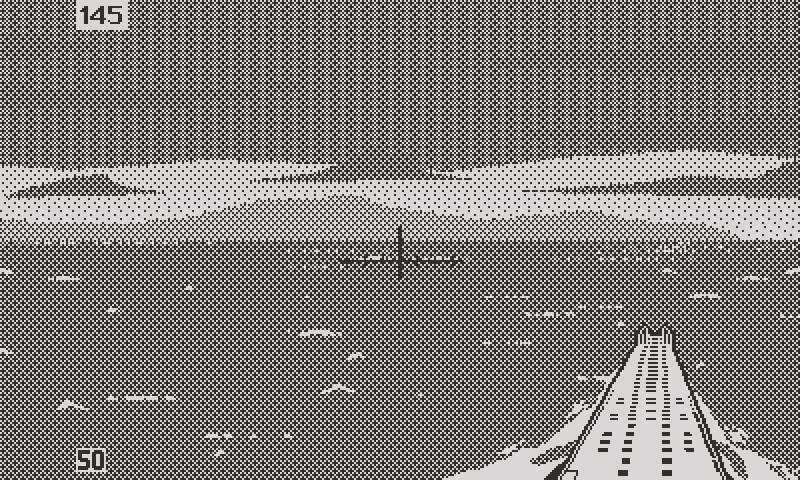
Bearing follows the tactical chart pointer
It all flows and feels responsive, which bodes well for the remainder of the tactical chart mechanics. I expect to progress quickly on this, and show more next time. But for now, I want to introduce the third major component of the engagement gameplay, which I’ve been teasing for a while: the Torpedo Data Computer (TDC).
From Life to Game
To understand the TDC, it’s best to go through a summary of how a torpedo was fired. Torpedo attacks aboard German U-boats always followed the same structure, with each phase simulated in the game with various degrees of fidelity. I’ll explain how each one happened in reality and how it translates into the game. Bear in mind that what follows is the simplification, for gameplay purposes, of a much more involved process. Evidently I don’t have experience as a submariner, nor am I a naval tactician, or an historian.
1/ Spotting the target
Reality
To shoot at something, you must be aware of its existence. It often started from the surface (where U-boats spent 80% of their time), with a signal from one of the four crew members on watch. A man would spot smoke in the distance, or a silhouette on the horizon.

Men on watch duty aboard U-177 in rarely seen tropical uniforms
Sometimes, the alert came from the radio operator who heard propeller noises through the hydrophone (a directional underwater microphone). An experienced listener could make the difference between warships and freighters (warships propellers revved much faster). He could detect an individual ship up to 30 km away, and large, loud convoys beyond 100 km. However, silence was crucial for an efficient use of the device. The boat had to be submerged with engines and motors off.

The hydrophone controls are on the left
Game
It falls onto the player to spot ships from the bridge or the periscope (it’s plausible since in reality the commander would take watch duty like any other crew member). In addition to that, you’ll have the opportunity to sit at the hydrophone yourself. This is a concession to realism, as commanders would rely on the radio operator. The hydrophone is useful for finding convoys across large distances between sectors, and for listening to potential threats before surfacing. The game’s hydrophone has the same limitations as its real life counterpart, which means that it’s useless on the surface and under propulsion.

Scanning for targets at night
The player may delegate watch duty and the hydrophone to the crew, their efficiency condition of their experience and other factors. I yet have to iron out the details of this feature, in particular the pros and cons of both methods for balanced gameplay.
2/ Acquiring target data
Reality
Once a target has been detected, it’s time to measure the parameters essential to an accurate firing solution. This data includes the ship’s class, bearing, distance, speed and angle on bow. The measurements were made either from the attack periscope, or using the UZO, a targeting device looking like goggles, that was temporarily mounted on the bridge for surface attacks.
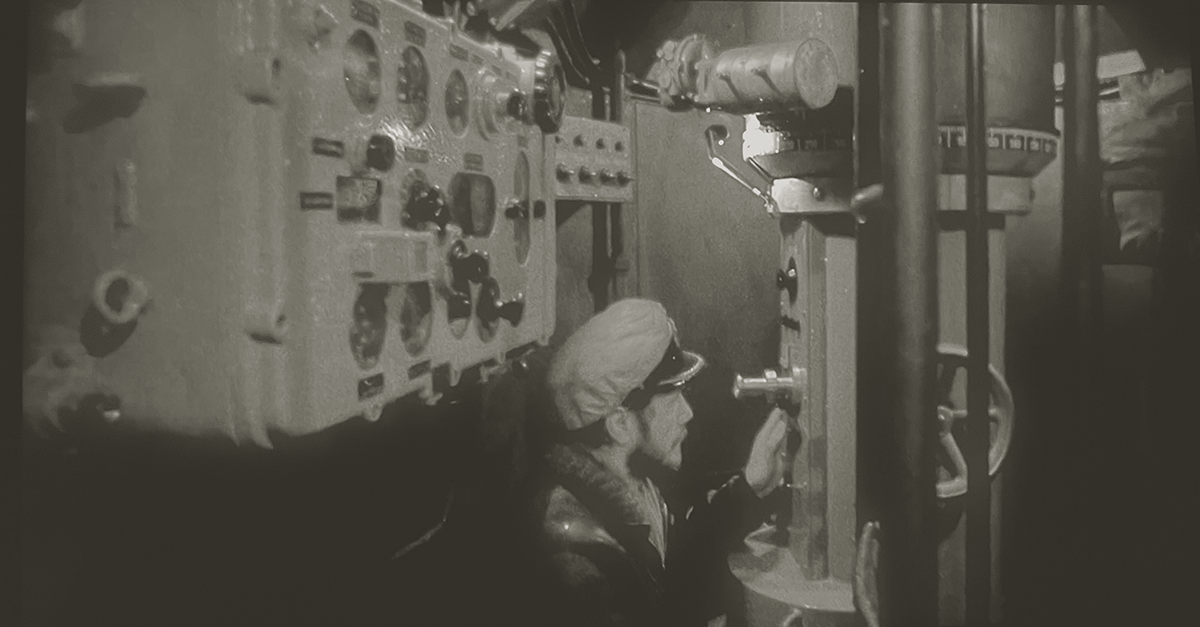
From Das Boot, the captain sits at the attack periscope in the conning tower. The TDC is on the left
I’ll spare you the details of the various methods and technology used. Suffice to say that early on these were visually assessed, and the result depended on the experience of the observer. Then U-boats were fitted with range finders and other measurement tools. With the range, basic trigonometry gives the angle on bow. From there it's easy enough to time the ship’s progression between two fixed points and deduct its speed. More on the angle on bow later.
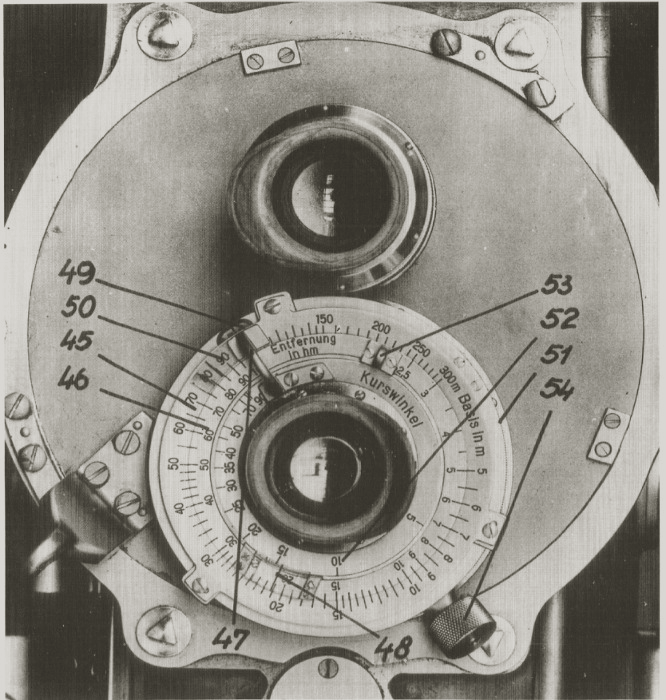
A german range finder
Game
In the game, all these calculations and measurements are done with a simple press of a button. Center the target in the UZO or periscope sights, then press A. The 1st officer will acquire all the data, give you a sum up, and the game shifts to the tactical chart, centered on the token representing the target. From now on, as long as the target remains observable (the U-boat has not dived below periscope depth, and the ship hasn’t left the visibility range), the data will be updated on the chart every turn, with all the information entered into the Torpedo Data Computer.

Acquiring a target data
Measuring a ship’s range, speed, or angle on bow aren’t that exciting, in particular if you must do all this on a tiny screen with a pad and two buttons. The fun comes from navigating the boat into the optimal position, avoiding detection, deciding which targets have the better odds (from studying the TDC data, more on this further down), when to attack…in other words making all the high level tactical decisions.
3/ Programming The Torpedo Data Computer and firing
Reality
The target bearing (the direction on the compass aligned with the target) was transmitted to the TDC via the aiming and target bearing transmitting subsystem, either from the UZO or the periscope. The other data, (target speed, angle on the bow, torpedo speed and target length) were set manually. The commander communicated these numbers verbally to the TDC operator.
The TDC then made all the calculations, resulting in the gyro angle and torpedo spread, which were transmitted via a link system to a gyro angle receiver, which in turn set the correct gyro angle into the torpedos (Early in the war, or when the link system was damaged, sailors had to set the gyro angle manually, following the TDC calculations). This resulted in the torpedoes steering toward the target, and forming a spread of regular intervals when several were fired.

The elements of the torpedo fire control system in U-505’s conning tower
Then the torpedo (or torpedoes) was launched and assuming that the measurements were correct, the target didn’t turn, and the torpedo wasn’t a dud, it was a hit.
Game
In the game, all you need to do is select a ship in the tactical chart and pick the "Firing solution" command. The game switches to the TDC screen, with all the data already programmed. The function of the TDC is to allow you to select torpedo types and assign the desired tubes to the target. But more importantly, having a complete overview of the data helps you judge of the probability of a hit. You know how close the target is, if it’s fast or slow, if it’s showing its broadsides, how large it is…and in addition to that, the TDC screen includes the target identification booklet, which informs about class, rarity, tonnage, armament, and speed, adding another layer to the equation. More on this further down.

Setting up the attack
I see the TDC as one of the places where the player makes the important calls. They decide if it’s worth firing, and the type and number of torpedoes to commit. Alternatively, they could try and maneuver to improve their odds first. But doing so implies the risk of detection, with time passing, which could lead to changes in visibly or weather. There’s a lot to do and master to do the job well as the commander. First on that list is understanding the factors that contribute to the odds of a hit.
A Series of Interesting Decisions
The TDC was a sophisticated piece of machinery, considering when it was conceived. As the brain of the U-boat, it made possible complex attack patterns comprising of several torpedoes fired in a spread at a moving target, even as the U-boat itself was in motion.

A Torpedo Data Computer without the cover
The same philosophy applies to the TDC as to the rest of the game: capture the essence of the realistic, historical procedure without what making it feel like a chore. Strip it of the complexity, but retain enough for the player to feel immersed and challenged with simple controls and meaningful decisions.
Studying the TDC, I was thinking about Sid Meier, of Civilization and Silent Service fame. He once said “Games are a series of interesting decisions.” There’s more to this quote than an apparent obvious statement. It’s a tool that can inform every design decision. With this in mind, I looked at all the choices that the commander must make when devising a torpedo attack, and what information is required to do so. As it turns out, this data is all available in the TDC, which makes sense, since the computer needs it to calculate a firing solution.
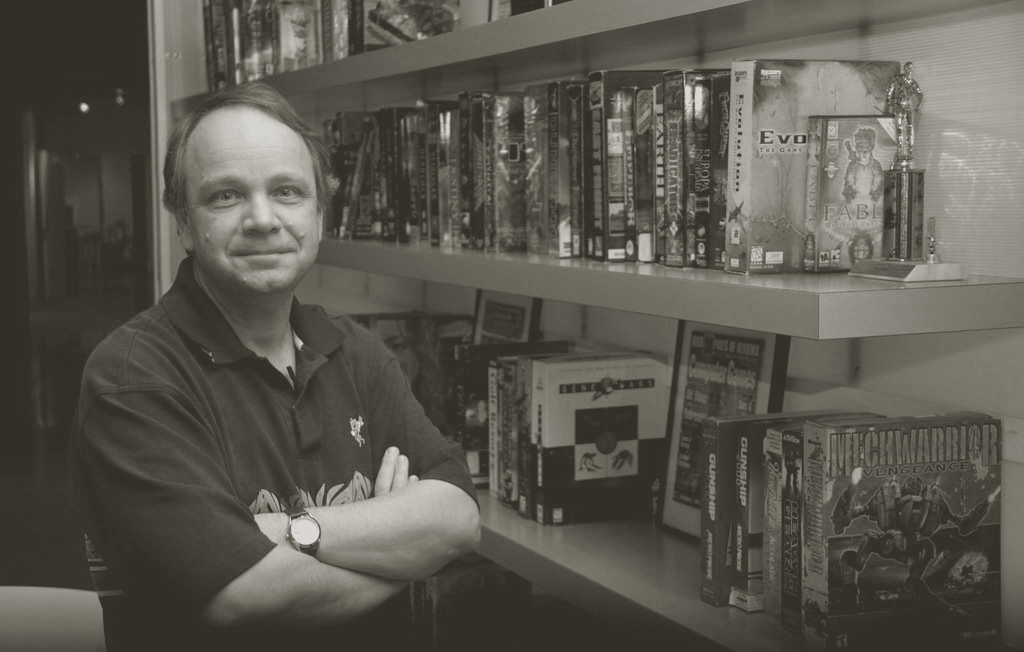
Sid Meier
I realized that a successful engagement comes down to improving the odds of torpedo (or deck gun) hits without pushing your luck to the point of jeopardizing your boat. And all the “interesting decisions” in this case revolve around that balancing act. What’s exciting is knowing what you need to do to improve your chances of success, what are the risks associated to these decisions, and weighting the risk with the reward.

Call me crazy but Railroad Tycoon is my favorite Sid Meier game
Now the TDC can be broken down into individual bits of information about the torpedo launch. Some of them are related to the target, and some of them to the U-boat. All have an influence on the result, and the majority can be controlled for a successful attack. According to Sid Meier, I must give to the player the opportunity of making theses changes. But equally important is getting rid of the busy work that only affects the outcome marginally.
One Screen
The TDC alone can’t inform on all the parameters of the attack. It lacks specifics about the target, weather and visibility conditions, and details about the current state of the U-boat, like ammunition. However the majority of the data should fit on one screen, limiting the need of jumping around for a complete overview. That meant designing a screen that would host not only the TDC, but all the additional information.
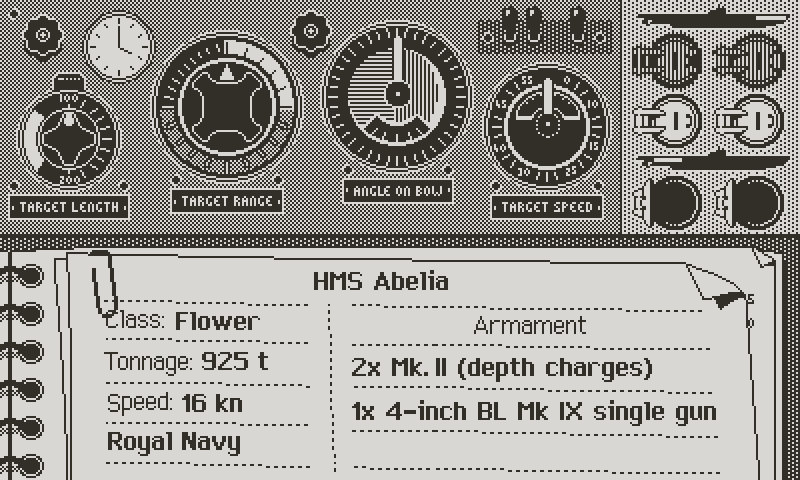
The TDC screen, comprising more than the TDC
This was the most challenging part of the mock-up. In the end, most of what the player needs is visible in one glance, with the occasional page shifting. The screen is divided into three main sections:
The top left part is the TDC itself, or at least a simplified version of the real device.
The top right panel is the arms section, to select torpedoes, assign tubes, or command the deck gun.
The bottom panel shows the ships identification book, used by U-boat commanders to identify their targets and learn about specs, like draft, length, tonnage, speed, armor and armament. This book shares the same space with the situation log, which sums up weather condition, visibility, and other relevant data, like the target’s behavior, or the remaining ammunition. The player can shift between the identification book and the log, which is the only concession to having everything visible at once.
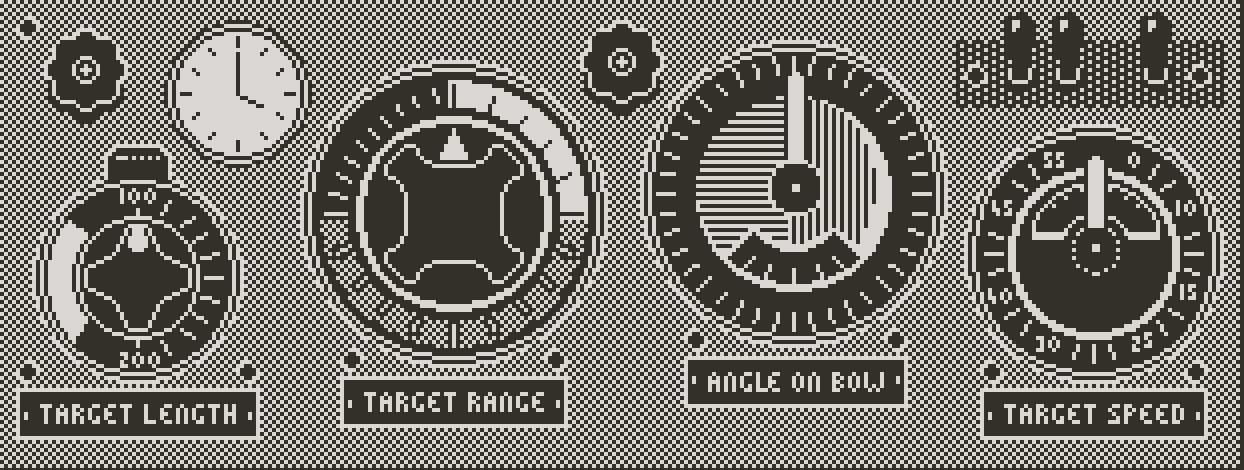
The Torpedo Data Computer
All the data within each panel has an impact on the chances of a hit, but the player doesn’t have the same level of control on each section. The TDC combines the data that can be indirectly influenced. For instance, distance to the target or angle on the bow can’t be instantly changed, but navigating into a better position can improve them. The target’s speed isn’t under the player’s control, but avoiding detection or inflicting a crippling blow ensures that the target won’t try or won’t be able to flee.
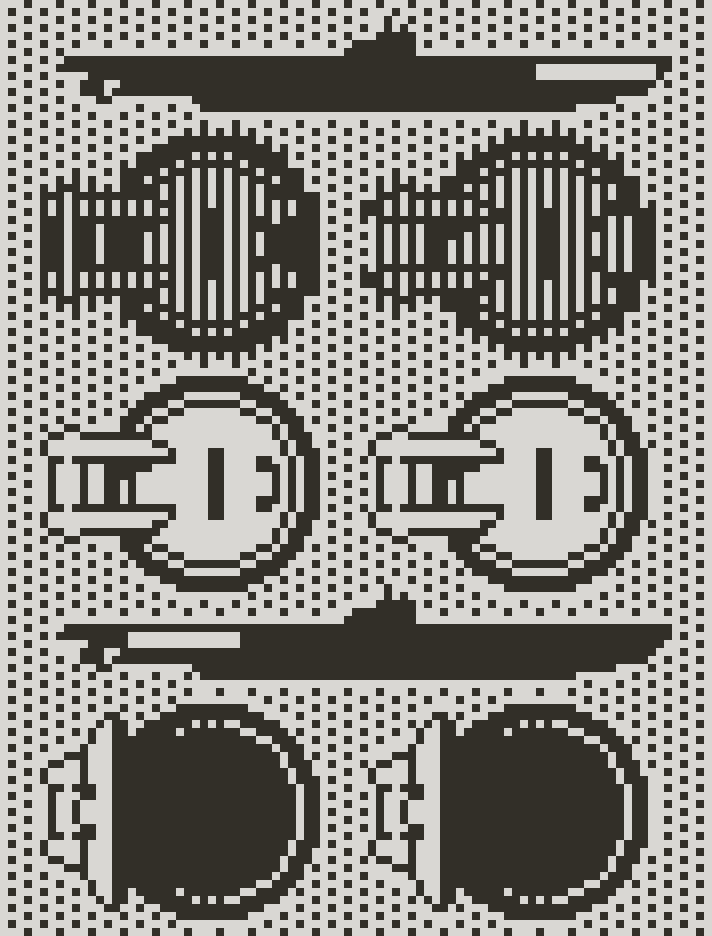
The arms panel
The armament panel is under the direct control of the commander, who can choose to fire the deck gun or launch torpedoes, in which case he selects the type of torpedoes and the tubes to load.
Finally, the bottom panel gives additional parameters, which factor into the decisions of the commander, but he has no control over them.

The situation report
Hopefully, that way of breaking down the data makes it easier for the player to focus on what they can do, while being informed on what they can’t control. Now let’s study each panel in detail.
The Torpedo Data Computer
A number of gauges, controls and indicators of the authentic TDC are represented in the game. A few are merged or omitted, and instead of performing the complex calculations for a gyro angle and spread, the game’s TDC comes up with a hit percentage. In that sense, the TDC is a way to estimate how favorable the parameters are. Is the target within acceptable range? Is it large? Is it oriented at a preferred angle? Does it move fast?
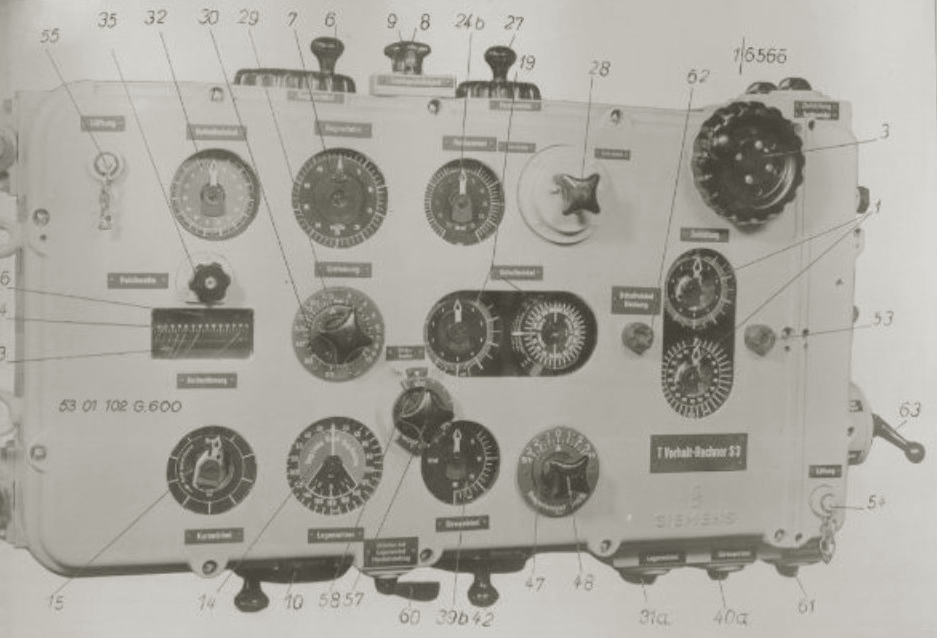
A german torpedo data computer
The most impactful data is included in the TDC, while secondary factors (in the situation log), like weather and target’s behavior, also affect the outcome to a lesser degree.
Here’s a breakdown of every indicator of the TDC, with the real one for comparison (or at least the Uboat PC game version, which is the clearest reference picture I could find of the authentic device). One important note: the resolution of the Playdate is too small to be able to read the display on the gauges. However the numbers themselves don’t matter (even though they are within realistic range). Each gauge is designed in a way that allows the player to read how close to optimal the value is, which is all that matters in the context of the game. Pay attention to the size of the gauges however. The larger they are, the more they weight on the result, which means for instance that the distance to target is more critical than its length.
Now, from left to right:
1/ Target length
It’s the size of the targeted ship. The larger ones are easier to hit. A large dot shows the value, with the bigger, better number (200 m) at the bottom.

2/ Clock
A reminder of the time, which can affect visibility conditions. A white clock means daytime, and it turns black at night time. The same clock is displayed in the top corner of the tactical chart.

3/ Target range
The distance to the target in meters. This gauge reads clockwise. It’s broken into three zones, corresponding to short, medium, and long range. The bonus to hit is a direct factor of the exact distance, but three sections help to get a rough appreciation of what’s considered optimal, decent, or bad. Short range, from 0 m to 1,500 m, covers the first quarter. Medium range, 1,500 m to 3,000 m, goes from 3 o’clock to 9 o’clock. Long range, 3,000 m to 6,000 m, covers the last quarter. In reality, torpedoes could travel up to 12 km, but commanders tried to attack from no more than 1 km away. In the game like in reality, torpedoes need 300 m to arm, which makes it the minimal firing distance.
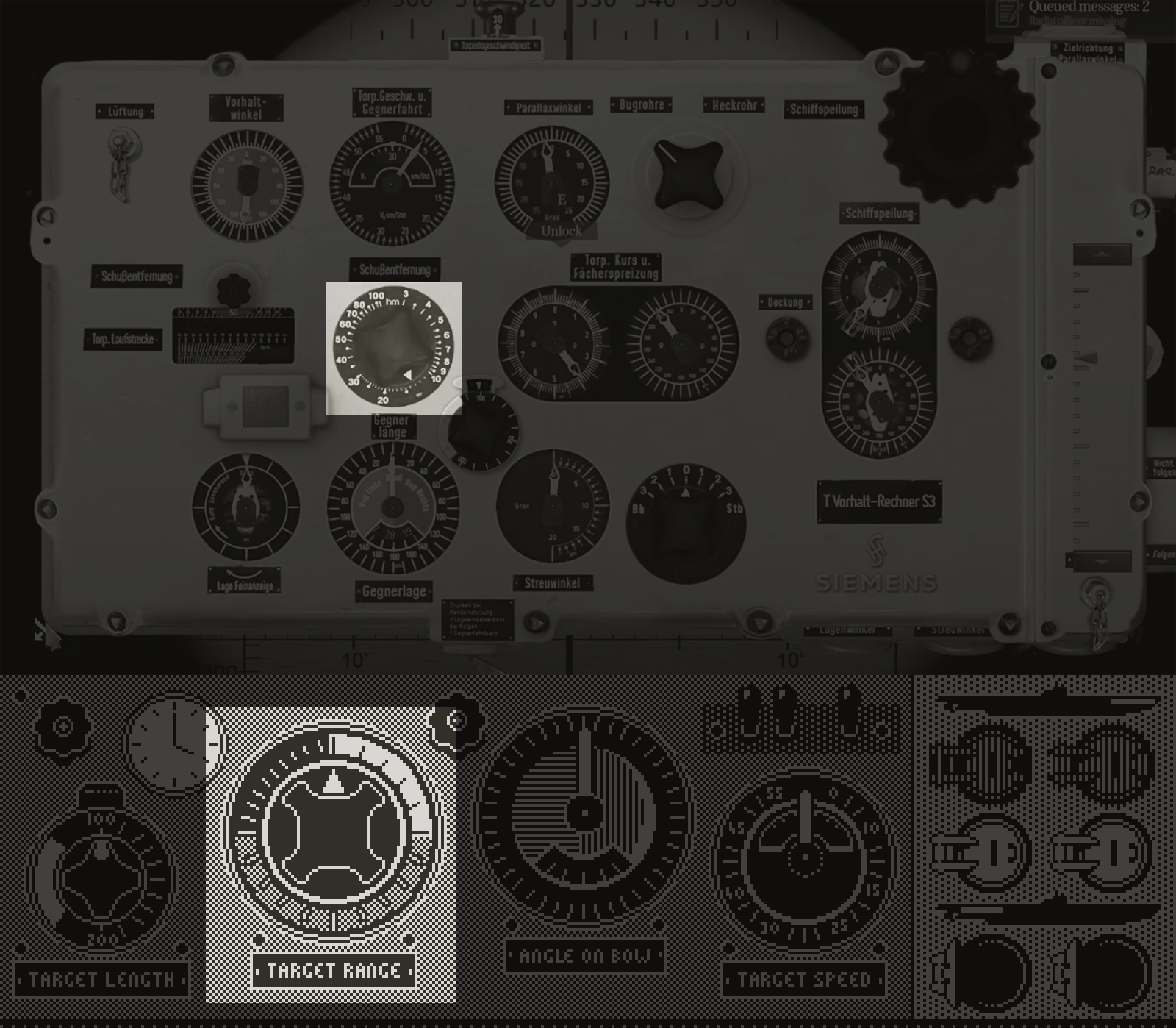
4/ Angle on bow
The game’s angle on bow is substituted to the track angle (or angle of impact). The angle on bow is the angle between the target bearing and the target heading. The track angle is a factor of multiple parameters of the shot, (including the angle on bow) and it’s the angle at which the torpedo hits the target. To make things simple, a torpedo has better chances of success when hitting the target at a right angle, because the ship offers more surface. A torpedo hitting a ship from the back or the front, at a parallel angle, is likely to miss.

The realistic calculation of the track angle would be challenging for me to code and difficult for the player to visualize. I chose to amalgamate the track angle and the angle on bow; the angle on bow is easy to see in the chart and the player can try and improve it by studying projected courses.
The values read from 0 degrees at the top to 180 degrees at the bottom. The closer to 90 degrees the better, so the needle must be as horizontal as possible. Left or right doesn’t matter.
5/ Target speed
This is straightforward. The values read clockwise, in knots. As one could expect, the slow targets are easier to hit.
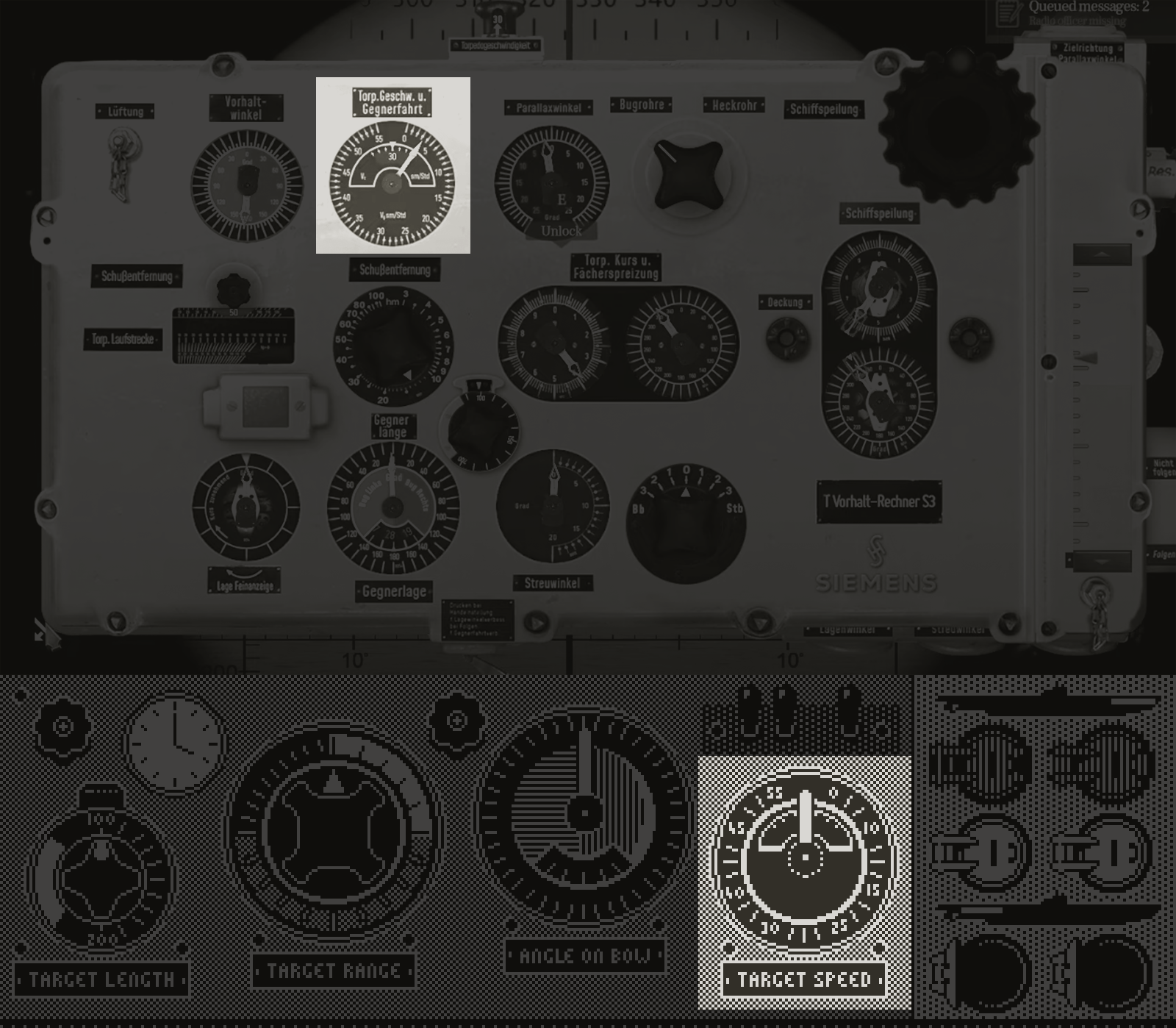
The Armament Panel
To the right of the TDC sits the arms panel. It’s the direct access to torpedo tubes and the deck gun. I haven’t designed the gun section yet, so I’ll focus on the torpedoes. The layout reflects the configuration of the boat. This is an example of the type IX configuration, with four bow tubes and two stern tubes.

I hope to make the controls as intuitive as possible. You select the tube with the directional pad, press A to open the tube, select the torpedo type (electric or steam), and confirm. A number on the tube indicates it’s loaded, with the number showing the torpedo type (1 for g7a steam, and 2 for g7e electric). Steam torpedoes were faster (which in the game will translate with a bonus to hit) but left a trail of bubbles, which made them easy to spot, and could give away the U-boat’s position. They were generally reserved for night attacks. Electric torpedos were slower but safer to use.
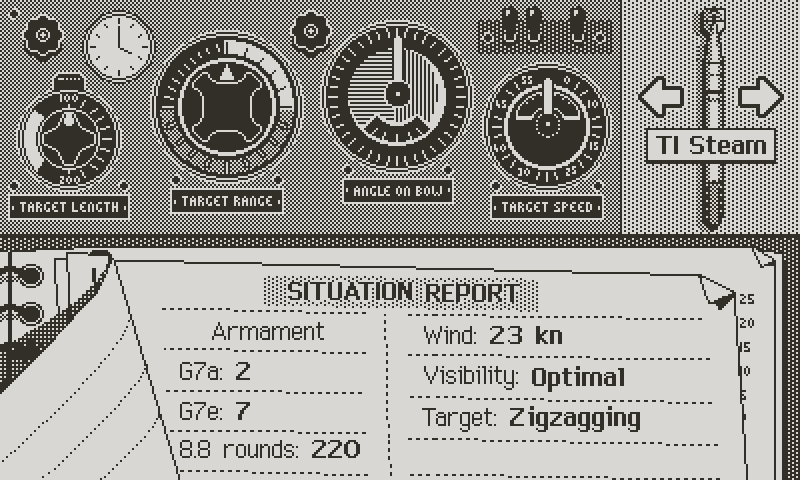
Selecting a torpedo
I still have to iron out some kinks, but I imagine that a greyed out tube will indicate that it’s already loaded for another target. You can still select it, but doing so overrides the previous target with the one currently selected in the TDC. An open tube is empty and available.
The Ships Identification Book
Target identification is critical for obvious reasons, but without modern technology, it was left to the judgment of commanders, and it led to many tragedies. One of the most infamous was the Laconia incident, when a type IXC U-boat led by commander Werner Hartenstein, sunk the RMS Laconia, carrying 2,732 crew, passengers, soldiers, and Italian prisoners of war.

A ship identification book
The rules of submarine warfare considered troop transports legitimate targets, and the commander mistakenly believed this was the case due to the Laconia being armed with a 6-inch naval gun. After realizing his error, Hartenstein ordered all the survivors to be rescued onboard the U-boat. Many of them had to stay outside on the deck, or towed aboard life rafts. The commander sent an un coded message on international band signaling any ship in the vicinity that he was carrying civilians to land and asking not to be attacked.

Angle on bow illustrations
A rendez-vous was organized with vessels from the French government of Vichy (then under German occupation), to take the Italians. On her way there though, the U-boat was attacked by an American B-24 aircraft, even though she was sailing with a Red Cross flag across her gun deck and Hartenstein had communicated his situation to the pilot in Morse code. The attack killed a number of people in the life rafts. Hartenstein had no choice but to cast adrift the people he had meant to save, asking them to wait there for the French ships.
The incident led Admiral Donitz to issue the Triton Null Order, later known as the Laconia Order, which prohibited U-boat crews to rescue anyone resulting from an attack (even though the order was ignored in multiple occasions). It’s worth noting that Allies had similar orders in effect. There’s been other incidents of that nature, on both sides, across all theaters of operation, leading to the loss of many lives, because of identification mistakes.
Commanders were given books documenting hundreds of allied and enemy ships, to help them identify their targets. Each entry compiled data about the ship, like length, mast height, speed. Without these specifications, it was impossible to calculate the parameters to enter into the TDC, like distance or angle on the bow. In addition to the specifications, illustrations showed the ships from various angles to estimate the angle on the bow before automatic measurement was available.
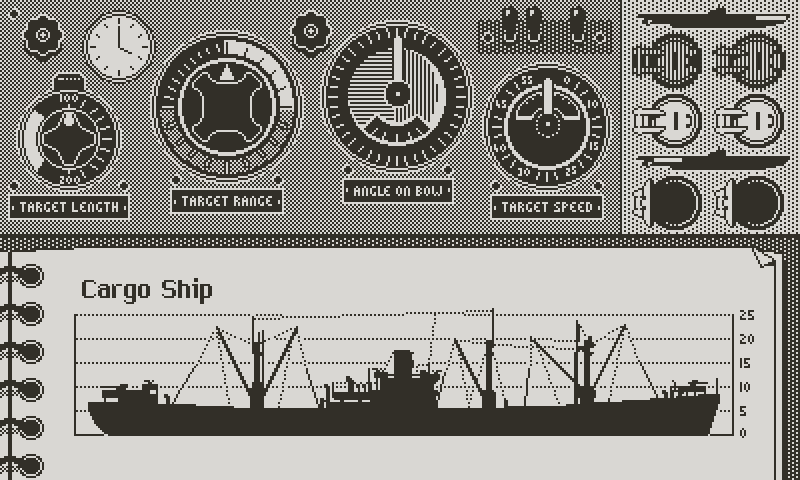
Cargo ship identification illustration
In all fairness, the identification book illustration in the game is merely for flavor. But it's the only opportunity to show ships in greater detail. I’ve always loved schematic and technical illustrations in games. Somehow they make the world more tangible, more technical. And if I'm honest, it's good fun to draw the art.
But there’s one unresolved question about the visual treatment. Historically, the ships were represented as black silhouettes, from the waterline and up. By hiding details and the submerged part of the hull, the drawing remained as close as possible to how the ship would look like in situ. As an experiment I drew a couple of ships with more shading and details, and the entire hull visible. I’m torn between the two. The silhouette has a clean look that feels more in scale, and it’s faithful to the authentic illustrations. The shaded drawing is more interesting to look at, but lacks authenticity, and I’m not sure if scale comes out right. I’ll let this sink in and make a decision later. Let me know what you think in the comments.

Not sure of the right direction for the art
Not every aspect of the identification book is for show. A second page per ship compiles useful information, like speed and weapons. It also mentions the target's class, if it's a unique ship, like a known battleship or aircraft carrier. Reading this page helps to measure the level of threat of the target against its value; it's the risk/reward assessment part of the attack.

Flower class corvette data
When writing about the tactical chart, I mentioned my goal of giving an analog, vintage feel to the UI, with paper, rulers, compasses, and pencils. I took reference from old spiral bound notebooks for this panel. Loose sheets of papers are held together with paper clips. Pages have folded corners. It helps this screen to fit in the same universe as the tactical chart. I mocked animations for browsing through the book. Nothing new there; the old page flick has been done a million times, but there's no shame in using the old tricks when they do the job.
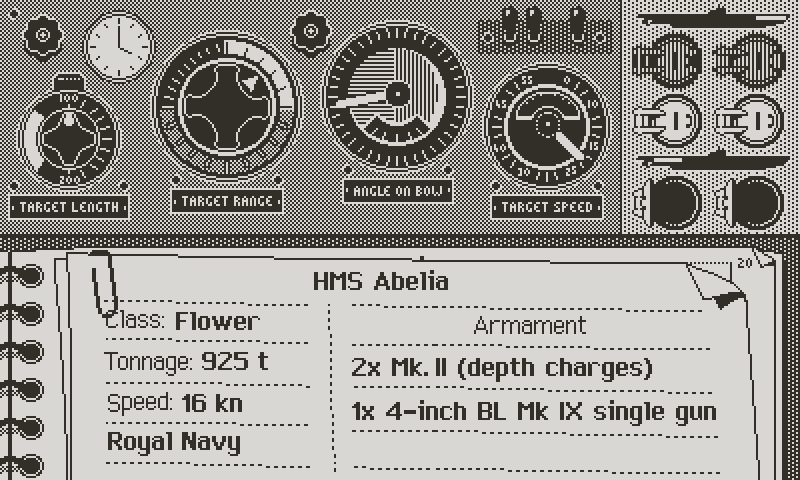
Page flip animation mock-up
The Situation Report
The situation report sums up the few parameters that aren't specific to the target. Visibility is a result of the time, weather, and moon phase at night. Target's behavior signals anything that could affect the firing solution. Convoys used to zig zag, in particular when they suspected the presence of U-boats. The idea is that the TDC can only calculate a solution with the assumption that the target will maintain constant speed and heading, which is often the case. But any course correction after the torpedo was launched would result in a miss, at least until the acoustic homing torpedoes came into service in 1943.
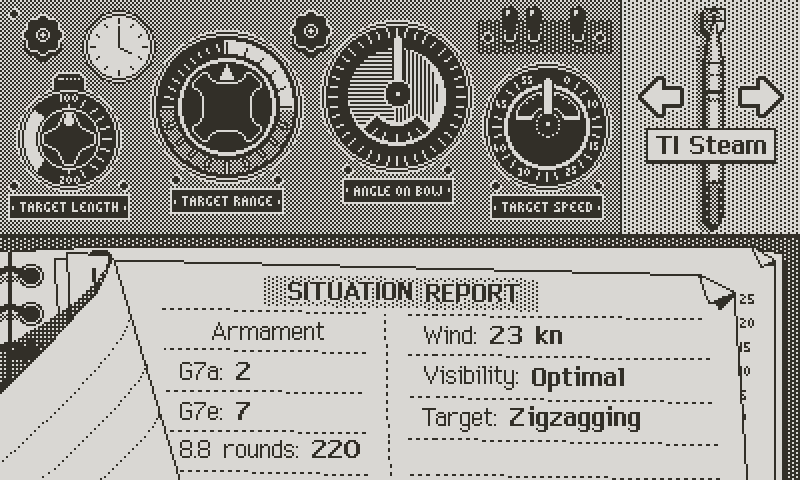
The left half of the situation report keeps track of ammunition, which is important to have available when loading torpedo tubes or firing the naval gun. More detailed information about the boat, like damage, will be available from the schematic view, which I'm not even close to start working on.
Between the tactical chart and the TDC screen, I think that there's enough easy to access information for the player to make informed offensive and defensive decisions. Only a fully working prototype of the three main screens will make this a certainty, and there's a lot of work before that happens. But I feel like as development progresses, I become more comfortable with coding, and and I have more building blocks and functions ready to use. I can't wait to see this all put together and finally get the sense of playing what could pass for a game.
Now the next steps are to finish the implementation of the tactical chart and the TDC. I have enough mocked up to keep me busy the upcoming months, but I plan to set time aside to mock up other parts of the game, and break up the long coding streaks. The one coming to mind first is the end of turn sequence, where you'll get to see your torpedoes hit (or miss), and the enemy ships fire guns or launch depth charges. This should be one of the most tense and fun parts of the game.
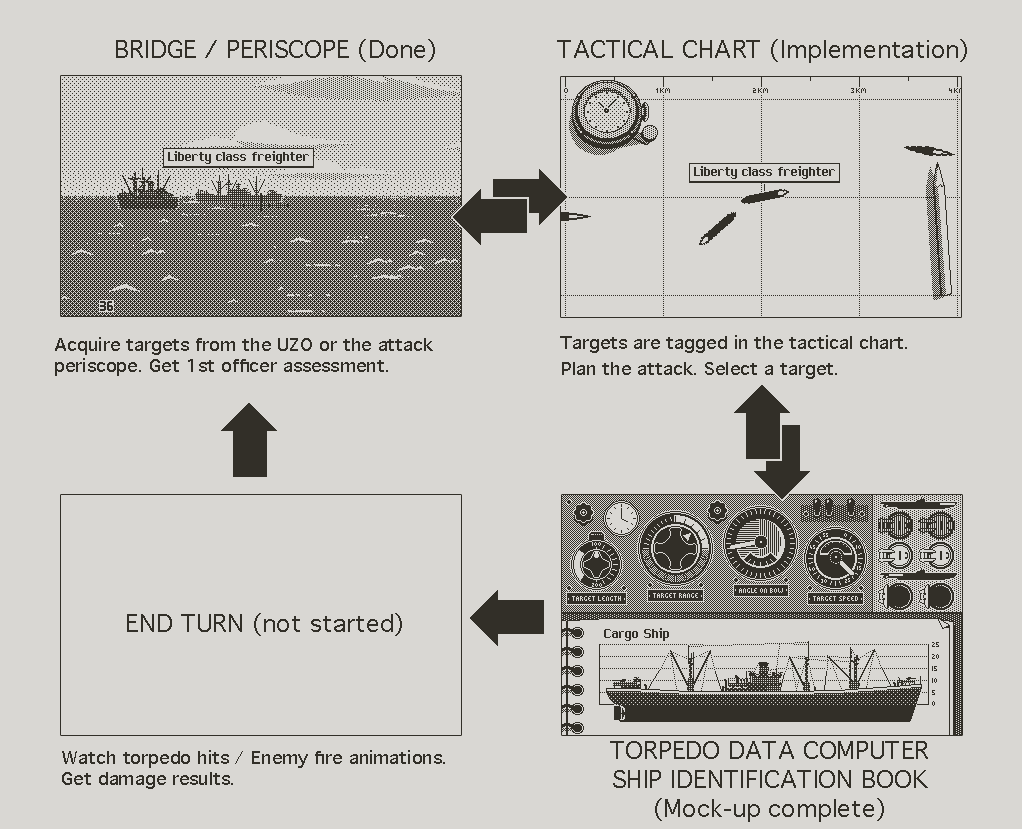
Current state of the game
On a personal note, I will visit my family in France for three weeks in October, which will delay development. This year I've been able to maintain the pace of one update every six week on average, but the next log isn't likely to come before the end of the year, considering the amount of things to do and the three weeks hiatus. I may put together a small entry with screenshots and gifs of any significant progress before that.
So, you know it, more soon.
Atlantic '41
A WW2 U-boat Simulation for the Playdate
| Status | In development |
| Author | StephanRewind |
| Genre | Simulation |
| Tags | 1-bit, Pixel Art, Playdate, Turn-based Strategy, World War II |
More posts
- Upcoming log and Cranko! interview11 days ago
- Visual Upgrades55 days ago
- The Enemy (Part 2)Aug 31, 2025
- The Enemy (Part 1)Jul 15, 2025
- Los!May 29, 2025
- Preparing the FutureApr 07, 2025
- Project ResetApr 01, 2025
- Small BeginningsFeb 24, 2025
- Death by a Thousand ShellsDec 17, 2024
- Next devlog a bit delayedOct 13, 2024

Comments
Log in with itch.io to leave a comment.
A vote for solid black. Love all the physicality! Can't wait to see the dials in motion. Was wondering if had taken a look at HighFleet for a recent example of physical interface games?
Thank you for the feedback. Silhouettes are getting ahead in the poll, which is fine, since it’s quicker to do.
I haven’t seen this game. I don’t play as often as I’d like. The thing with “physical” UI is that they can be overwhelming. On the tiny Playdate screen it’s a concern, so I have to find a balance. I’m still refining the controls in the tactical chart at the moment, counting the button presses to activate a command :)
I think the solid black silhouette looks best and is the most practical for the Identification Book. Great devlog as always!
Thank you. It seems like the preferred opinion at the moment.
Longtime lurker but had to sign up just to compliment you on not just the SPECTACULAR design and engineering work here, but also your process posts! I love reading this, seeing it, and it is all so wonderfully detailed and well executed. I am really excited for this game.
I have no strong opinion on the ship book design sadly — I share your sentiment that it looks really really good shaded. I think it should show the waterline a bit better, and would benefit perhaps from a halfway point where there is _some_ shading but it is overall fairly dark and silhouette-y?
Keep up the amazing work. Huge fan. I would pay a lot for this game!
Thank you for your support and taking the time to sign up just for that! I’ll keep your suggestions in mind. Don’t worry I don’t plan to price the game unreasonably ;)
Fantastic. Phenomenal design work on the TDC and Book screen. Amazing, really.
Thank you so much :) Very glad that you like it!
It all looks so simple and obvious now, but I know to get to that point it takes a ton of thinking, planning, dead ends and real work!
Riveting read, as usual :)
Arguments notwithstanding my insticts goes with silhouettes.
Reading all this I'm struck by an intense desire for the game to be accompanied by an actual paper book manual. Tiny, like the playdate itself, but well designed, with fun authentic details. Probably unrealistic given the work and logistics involved but one can dream.
Thank you. Well funny you should mention the paper book because I’ve been toying with the idea of kickstarting a limited physical edition that would have proper box like the old computer games, as well as feelies (maps, identification booklet etc…).
This is a tricky one to pull off, but if I was able to find 100 or so backers, there might be a way to finance a very small run. I’m going to study the costs and look for printing vendors and such so by the time the game is ready, I’ll be able to post something here and gauge if there’s enough interest.
Fascinating. The main loop sounds solid. Can't wait for this game.
I've been curious about the ship identification book since I saw it in The Enemy Below (the film that, as I understand it, was the inspiration for Balance of Terror, the excellent Star Trek episode that introduced the Romulans).
Yes Balance of Terror and The Enemy Below are both classics!
Great stuff as always.
How do you feel about progress? It must be good to be able to stamp a big fat DONE on one part of the game. I feel you have a healthy motivation to keep going while also spending time on other things in life. That’s something to be proud of as single dev, cheers!
By the way, I think I would go with the silhouette ship images although I agree with your arguments.
Do have an idea yet how the player will learn that a horizontal hand on the angle on bow dial is ideal?
Thank you for your always kind encouragements. Going the distance is, I think, the single most challenging aspect of solo game development. I’ve been doing okay in the past, which I owe to my personality; I get very upset when I give up on something I set out to do, even to an unreasonable degree.
Still this game is more complex than anything I’ve attempted before and sometimes I’m concerned about the long road ahead of me. But truth is that I have better odds of finishing a “big” game that I’m passionate about than a small one I don’t care for.
Now I declare the exterior views done, but I still have aircrafts, more animals and other small things I don’t want to spoil, but it’s at a point where I feel confident enough to move forward. I want to try and bring features to 85% in order to get a sense of the loop and the flow of the full game as quickly as possible, and then come back to polish / add less non crucial content.
Thank you for sharing your opinion on the illustrations. I tend to agree with you but there’s no rush to decide. In the end, all things being equal, if I can’t find a definitive advantage for either option, I always go for the less difficult or time consuming, which would be the silhouettes in this case.
I will have an interactive tutorial to teach the player every aspect of the game, including how to read the gauges, but it may not be enough now that you point this out. I’m going to add white and grey arcs on each side, which will be the “best” and “average” zones, similar to the range. In fact I should make sure every gauge has a similar color code. I think this may be an effective and elegant solution. I’m glad that you asked the question. Thank you for this.
Awesome stuff; thank you for allowing us such a deep look behind the scenes in its development. (I shudder to think how many hundreds of dollars this game will cost when it goes live. 😉)
Thank you! lol I don’t think that players should pay for my madness. It’s too early to think about pricing yet, but I’m definitive: it will be in line with other games for the Playdate. ;)
As always, very interesting and informative dev logs and I can't wait to play what looks like to become a playdate gem.
Thank you very much!
Forgot to comment on the ships' look.
The shaded version is definitely more interesting and the silhouette looks "uglier" (to me), but that's probably because of the comparison. Maybe on an actual playdate screen and without the shaded version close to it, the feeling might be different.
The argument about keeping historical authenticity, though, is strong, especially because that's what you are striving for. And hearing about it makes me look at the silhouette in a better way.
Thank you for sharing. I’ll keep everyone’s opinion in mind.